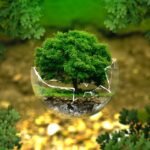A new study has revealed that significant portions of Greenland’s ice sheet have transformed into vegetation, posing risks such as increased greenhouse gas emissions, rising sea levels, and landscape instability. The research, which analyzed satellite records from the past three decades, estimates that approximately 11,000 square miles of Greenland’s ice sheet and glaciers have melted since the 1980s. This area is equivalent to the size of Albania and represents 1.6% of the total ice cover.
As the ice has retreated, barren rock, wetlands, and shrub growth have replaced the ice, leading to a change in the environment. The study shows that the amount of land with vegetation has increased by 33,774 square miles, more than double the area covered when the study began. The expansion of wetlands has been particularly significant, with a near-quadrupling across Greenland. This increase in wetlands is a concerning development as they are a source of methane emissions, a potent greenhouse gas.
The researchers have also observed signs that the increased vegetation is contributing to further ice loss. The greatest growth in dense wetland vegetation has been observed in Kangerlussuaq in the south-west and in isolated areas in the north-east of Greenland. The scientists attribute the ice retreat to warmer air temperatures, with the region heating up at twice the global average rate since the 1970s. Between 2007 and 2012, the average annual air temperatures in Greenland were 3 degrees Celsius warmer compared to the period between 1979 and 2000.
Jonathan Carrivick, an Earth scientist at the University of Leeds and a co-author of the study published in the journal Scientific Reports, warns that the loss of ice is triggering a chain reaction that will result in further ice loss and greening of Greenland. As the ice retreats, bare rock is exposed and colonized by tundra, eventually leading to shrub growth. Additionally, water released from the melting ice is carrying sediment and silt, forming wetlands and fenlands.
Dr. Michael Grimes, the lead author of the report, highlights the significant impact of these changes on coastal waters. The expansion of vegetation alters the flow of sediments and nutrients into these waters, which is crucial for Indigenous populations whose traditional subsistence hunting practices rely on the stability of these delicate ecosystems. Furthermore, the loss of ice mass in Greenland is a major contributor to global sea level rise, posing significant challenges now and in the future.
The researchers have used their findings to develop a model that predicts areas on Greenland that are likely to experience marked and accelerated change in the future. This model will enable ongoing monitoring of the situation.




